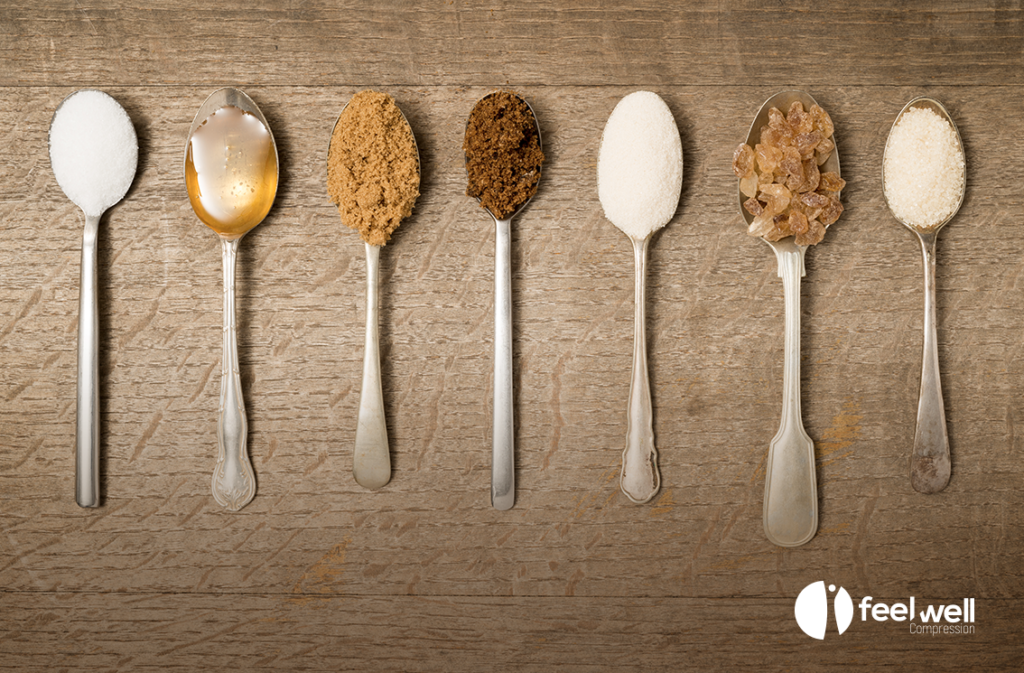Americans consume an average of 17 teaspoons of sugar each day. The recommendation is 6 teaspoons for women and 9 teaspoons for men. This includes the two types of sugars in the American diet; added sugar and naturally occurring sugar.
Naturally occurring sugar is sugar that is found in foods without having to be added in. They are a part of the food’s chemical makeup. Fruit is probably the best example of a food that has naturally occurring sugar. This sugar is called fructose and it is what gives fruit it’s sweet flavor.
Added sugar, however, is the sugar that has been added to a food item that was not there naturally. This sugar is often synthetic or processed. This type of sugar is becoming a hot topic in health and nutrition. The FDA issued a regulation requiring all food manufacturers to list added sugar on their food labels by 2021. Those with over $10 million in sales have until January 1, 2020 and those with less than $10 million have until January 1, 2021
What is added sugar and why is it so important to know when your food has added sugar? Added sugar refers to sugars and syrups that are added to foods during preparation, processing, or at an individual’s own table.
Sources of Added Sugar
Soft drinks, candy, desserts, and fruit flavored drinks are the primary sources for added sugar in the usual American diet. In fact, sugar-sweetened beverages account for 1/3 of the added sugar in American diets. There are still some foods with added sugar that are quite surprising. Dairy and milk products contain added sugar, specifically yogurt and sweetened milk. Some foods that are generally thought of as healthy contain added sugars such as protein bars, cereals, bread, canned soups, sports drinks, salad dressings, and flavored oatmeal.
Added Sugar on Nutrition Labels
Added sugar being required on food labels was originally set to be a standard by July 2018. However, this was pushed to 2021 at the latest. So what is a person to do when wanting to know if their food has added sugar?
A great place to start is knowing that the sugars line on a food label includes both added
and naturally occurring. The easiest way to find added sugar is to look at the ingredients
label and be familiar with the various names for added sugar.
Those include:
- Brown sugar
- Corn sweetener
- Corn syrup
- Fruit juice concentrates
- High-fructose corn syrup
- Honey
- Invert sugar
- Malt sugar
- Molasses
- Raw sugar
- Sugar
- Sugar molecules ending in “ose” (dextrose, fructose, glucose, lactose, maltose, sucrose)
- Syrup
Impact on Health
The human body does not require sugar for proper and optimal function. Since some sugar does occur naturally in foods the body is able to process this natural sugar, meaning that it is able to be broken down and absorbed. This is not the case with added sugar. Added sugars provide what is referred to as empty calories. When an apple is consumed, it contains about 19 grams of sugar, but it also provides vitamins, minerals, and fiber that the body needs for healthy functioning. Added sugars provide calories alone. This leads to an increase in daily caloric intake and eventually weight gain.
A research study based out of Harvard Medical School looked at participants over a 15- year period and discovered that participants who consumed 25% or more of their daily calories from sugar were more than twice as likely to die from heart disease as compared to those that ate less than 10% added sugar.
Added sugars crowd a healthy diet. When an individual has a diet high in added sugar it is inevitably going to be low in essential vitamins and nutrients. In addition to providing empty calories added sugars in sweetened beverages may also increase blood pressure and cause the liver to release harmful fats into the blood. Both of these side effects from added sugar will increase a person’s risk of heart disease.
Where is the Line?
Added sugar is hard to avoid. Because of this the American Heart Association has made recommendations on limiting added sugars to no more than 9 teaspoons a day for men and 6 teaspoons a day for women.
Resources:
Trista K. Best MPH, RD, LDN


